Soft matter education†
Samuel A. Safran
Dept. Materials and Interfaces, Weizmann Institute of Science, Rehovot, Israel. E-mail: Sam.Safran@weizmann.ac.il
In the set of editorials that follow, several renowned soft matter researchers and educators expand on some of these issues. Prof. Tom Lubensky of the University of Pennsylvania and a member of the U.S. National Academy of Sciences introduces the field, and then writes about the various modes through which graduate students are educated in soft matter. A co-author (with Paul Chaikin) of a graduate-level text that pioneered the instruction of “ħ = 0 physics” of systems in which the competition of interactions with thermal energies leads to broken symmetries, order and fluctuations, Lubensky goes beyond traditional classroom education in his descriptions of various methods and resources that enable graduate students to learn soft matter physics. More recently, it has been realized that soft matter classroom instruction should percolate down to the undergraduate level, so that those students can appreciate the beauty, utility and challenges inherent in the field. Prof. Richard Jones, Fellow of the Royal Society and Pro-Vice Chancellor for Research and Innovation at the University of Sheffield is the author of Soft Condensed Matter, a shorter and mathematically milder introduction to the topic. In his editorial, he outlines how the teaching of soft matter at the undergraduate level motivates students to appreciate the relevance and immediacy of this field, while also providing them with physical-science tools for understanding living matter.
An even more radical paradigm shift is espoused in the editorial by Edit Yerushalmi of the Weizmann Institute of Science on the rationale and implementation of a program on “Soft and messy matter” offered to high school students who concurrently study “advanced placement” level physics or chemistry; this cohort is similar to first year university-level students. As an internationally recognized physics education researcher, Yerushalmi is well aware of the compartmentalization of science at the introductory level. One of the consequences of this introductory-level, interdisciplinary and supplementary soft matter program is the lowering of barriers between physics and chemistry via the contact students have with both learners and instructors from both disciplines, as well as their exposure to the fundamentals of statistical thermodynamics and their applications to soft matter. Moreover, since introductory physics typically tends to focus on single (or two) particle systems, the program extends the horizons of high school/introductory level physics students to include multi-particle interactions and collective behavior, which underlies many interesting, useful and everyday phenomena. This continues and formalizes the tradition started by P. G. de Gennes in the high school lectures he gave after winning the Nobel Prize; those lectures are summarized in the book “Fragile Objects”.1
Prof. Erich Sackmann of the University of Munich is a distinguished physicist who almost single-handedly started the field of biological physics over 40 years ago. His editorial focuses on the teaching of upper-level or graduate courses on soft matter in biological contexts, and begins by putting biological physics in its historical context. Based on his experience, as exemplified in his recent textbook in biological physics, he then outlines the steps that should be followed in teaching each of the physics, physical chemistry and biology components; this includes the novel suggestion that a first (and purposely limited) introduction to biology and biochemistry be presented to physics students by physicists. While Sackmann is known for the influential and innovative experimental contributions of his research, his editorial also focuses on the important role of theoretical courses in biological physics. Not only is his enthusiasm for the subject infectious, but in a more practical vein, Sackmann points out how training in biological physics can open varied career paths.
While participation in teaching is often justified to research-focused scientists as necessary for the continuity of scientific knowledge, there may be other valuable benefits. In an article published in the August 18, 2011 issue of the Chronicle of Higher Education, Dan Berret discusses a report published by David Feldon in Science (August 19, 2011) entitled “Graduate Students' Teaching Experiences Improve Their Methodological Research Skills”. In addition, the article makes the point that teaching focuses the instructor on the importance, excitement and explicit formulation of the “big questions” in the field being taught. This forces the researcher to look outside of his/her narrow topic, and at the larger scientific questions. While true for almost any subject, these benefits may be particularly important in soft matter research, where analogies and generalizations about diverse types of matter have indeed led to the unifying concepts that have today made soft matter a contemporary, exciting and intellectually coherent discipline.
References
- P.-G. de Gennes and J. Badoz, Fragile Objects, Soft Matter, Hard Science, and the Thrill of Discovery, translated by A. Reisinger, Copernicus Books, Springer-Verlag, 1996 Search PubMed.
Footnote |
| † This article is part of a collection of editorials on Soft Matter Education. |
| This journal is © The Royal Society of Chemistry 2013 |

